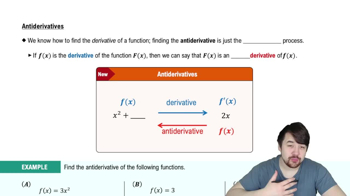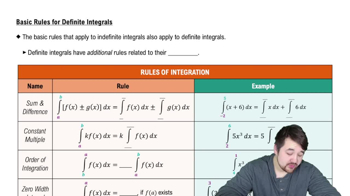Which of the following is an antiderivative of with respect to ?
Table of contents
- 0. Functions7h 54m
- Introduction to Functions16m
- Piecewise Functions10m
- Properties of Functions9m
- Common Functions1h 8m
- Transformations5m
- Combining Functions27m
- Exponent rules32m
- Exponential Functions28m
- Logarithmic Functions24m
- Properties of Logarithms36m
- Exponential & Logarithmic Equations35m
- Introduction to Trigonometric Functions38m
- Graphs of Trigonometric Functions44m
- Trigonometric Identities47m
- Inverse Trigonometric Functions48m
- 1. Limits and Continuity2h 2m
- 2. Intro to Derivatives1h 33m
- 3. Techniques of Differentiation3h 18m
- 4. Applications of Derivatives2h 38m
- 5. Graphical Applications of Derivatives6h 2m
- 6. Derivatives of Inverse, Exponential, & Logarithmic Functions2h 37m
- 7. Antiderivatives & Indefinite Integrals1h 26m
- 8. Definite Integrals4h 44m
- 9. Graphical Applications of Integrals2h 27m
- 10. Physics Applications of Integrals 3h 16m
- 11. Integrals of Inverse, Exponential, & Logarithmic Functions2h 34m
- 12. Techniques of Integration7h 41m
- 13. Intro to Differential Equations2h 55m
- 14. Sequences & Series5h 36m
- 15. Power Series2h 19m
- 16. Parametric Equations & Polar Coordinates7h 58m
7. Antiderivatives & Indefinite Integrals
Antiderivatives
Problem 4.9.13
Textbook Question
Finding antiderivatives. Find all the antiderivatives of the following functions. Check your work by taking derivatives.
ƒ(x) = 2 sinx + 1
 Verified step by step guidance
Verified step by step guidance1
Step 1: Recall the definition of an antiderivative. The antiderivative of a function ƒ(x) is a function F(x) such that F'(x) = ƒ(x). For this problem, we are tasked with finding the antiderivative of ƒ(x) = 2 sin(x) + 1.
Step 2: Break the function ƒ(x) into its components. The function ƒ(x) = 2 sin(x) + 1 can be treated as the sum of two terms: 2 sin(x) and 1. Use the property of antiderivatives that states the antiderivative of a sum is the sum of the antiderivatives of the individual terms.
Step 3: Find the antiderivative of the first term, 2 sin(x). The antiderivative of sin(x) is -cos(x). Therefore, the antiderivative of 2 sin(x) is -2 cos(x).
Step 4: Find the antiderivative of the second term, 1. The antiderivative of a constant c is cx, so the antiderivative of 1 is x.
Step 5: Combine the results from Steps 3 and 4, and add the constant of integration C. The general antiderivative of ƒ(x) = 2 sin(x) + 1 is F(x) = -2 cos(x) + x + C. To verify, take the derivative of F(x) and confirm that it equals ƒ(x).
 Verified video answer for a similar problem:
Verified video answer for a similar problem:This video solution was recommended by our tutors as helpful for the problem above
Video duration:
3mPlay a video:
Was this helpful?
Key Concepts
Here are the essential concepts you must grasp in order to answer the question correctly.
Antiderivative
An antiderivative of a function is another function whose derivative is the original function. In calculus, finding antiderivatives is essential for solving problems related to integration. The general form of an antiderivative includes a constant of integration, C, since the derivative of a constant is zero, leading to multiple valid antiderivatives.
Recommended video:

Antiderivatives
Basic Integration Rules
Basic integration rules are fundamental techniques used to find antiderivatives. For example, the integral of sin(x) is -cos(x), and the integral of a constant is the constant multiplied by x. Understanding these rules allows for the efficient computation of antiderivatives for various functions, including polynomials, trigonometric, and exponential functions.
Recommended video:

Basic Rules for Definite Integrals
Verification by Differentiation
Verification by differentiation involves taking the derivative of the antiderivative found to ensure it matches the original function. This step is crucial for confirming the correctness of the antiderivative. If the derivative of the antiderivative equals the original function, it validates the solution and reinforces the relationship between differentiation and integration.
Recommended video:

Finding Differentials
Related Videos
Related Practice
Multiple Choice
19
views


